
Running PPC Campaigns for Vaping Sites in 2024: Navigate Policies, Maximize Sales
Intoduction:
Advertising vaping products through Pay-Per-Click (PPC) campaigns in 2024 is challenging yet essential for brands looking to boost their sales and stand out in a competitive market. With strict ad policies and limitations on major platforms like Google, Facebook, and Instagram, marketers need to be creative, strategic, and compliant to run successful campaigns. In this blog, we’ll explore how to navigate ad policies, choose the right platforms, craft effective ads, and maximize sales through PPC campaigns in the vaping industry.
Why PPC Campaigns Matter for Vaping Sites
Vaping and CBD products are among the fastest-growing sectors, but traditional advertising methods have become increasingly difficult due to ad restrictions. PPC campaigns offer targeted ways to:
- Reach niche audiences.
- Drive traffic to your site.
- Generate leads and boost online sales.
However, major advertising platforms impose strict policies to limit or restrict ads for vaping products. Running a PPC campaign in this niche requires working around restrictions without violating guidelines, while still delivering high-converting ads.
Understanding Ad Restrictions in 2024
The first step to running PPC campaigns effectively is understanding platform-specific policies for vaping and CBD products. Each platform has its own set of rules:
- Google Ads:
- Prohibited: Google does not allow ads that promote vaping products, nicotine, or e-cigarettes directly.
- Workaround: You can create informational campaigns (such as blogs or non-promotional content) or target local keywords to drive organic traffic and brand awareness.
- Facebook and Instagram Ads:
- Limited Promotion: Ads that directly promote nicotine products or vaping devices are prohibited.
- Allowed: Campaigns focused on smoking cessation or educational content may be approved.
- Tip: Use creative storytelling that emphasizes lifestyle benefits without directly advertising products.
- Native Advertising Networks (e.g., Taboola, Outbrain):
- Native ads can promote vaping content indirectly by linking to blogs, reviews, or educational resources. These platforms are less restrictive than Google and Facebook.
- Programmatic Ads:
- Some programmatic advertising platforms allow ads for vaping-related products, especially if targeted to specific regions with relaxed regulations.
Choosing the Right Platforms for Vaping PPC Campaigns
Given the ad restrictions on mainstream platforms, you’ll need to explore alternative channels that can help you target the right audience while staying compliant. Some recommended platforms include:
- Native Ads: Platforms like Taboola or Outbrain allow you to promote educational content or product reviews, helping build brand awareness.
- Reddit Ads: Reddit offers advertising options for communities focused on vaping and CBD topics. Engage with specific subreddits to reach your audience authentically.
- Twitter Ads: While policies vary, Twitter may allow ads related to vaping or CBD in specific regions, making it a viable platform for testing.
- Programmatic Ads: Use platforms such as Criteo or StackAdapt to place programmatic ads in approved regions.
Crafting High-Converting Ad Copy for Vaping Campaigns
With restrictions in place, ad copy becomes the key to getting approval and maximizing click-through rates (CTR). Here are some tips for writing effective PPC ads for vaping products:
- Avoid Direct Product Mentions: Since most platforms restrict product advertising, focus on lifestyle messaging. For example:
- Instead of: “Buy Vapes at Discount Prices”
- Try: “Discover a New Way to Relax”
- Leverage Educational Content: Create ads that link to blog posts, guides, or how-to articles. For example:
- “Curious About Vaping? Explore Our Beginner’s Guide.”
- Promote Events or Workshops: Hosting events or offering free workshops on vaping or CBD can be a great way to drive traffic.
- Example: “Join Our Free Workshop on CBD & Wellness Trends for 2024.”
- Incorporate Keywords Strategically: Use non-promotional keywords like “vaping lifestyle” or “learn about CBD trends” to attract relevant traffic without triggering ad bans.
- Use Strong Calls-to-Action (CTA): While you need to avoid aggressive CTAs (e.g., “Buy Now”), you can still use subtle ones:
- “Explore New Trends” or “Learn More About Vaping in 2024.”
Optimizing PPC Campaigns for Maximum ROI
Once your campaign is live, it’s essential to continuously optimize for performance. Follow these best practices to ensure you get the most out of your PPC campaigns:
- Geo-Targeting: Focus on regions or countries where vaping ads are more lenient. This increases the chance of ad approval and better audience engagement.
- Example: Targeting European countries or specific U.S. states with more relaxed regulations on vaping products.
- A/B Testing Ads: Test different variations of your ad copy, CTAs, and visuals to see what resonates best with your audience.
- Landing Page Optimization: Ensure that your landing pages align with your ads to improve conversion rates. For example:
- If your ad promotes “CBD education,” the landing page should provide an informative blog or a guide.
- Retargeting Campaigns: Use retargeting ads to engage users who visited your site but didn’t convert. Offer special discounts or invite them to join your mailing list.
- Track Performance with Analytics: Monitor key metrics such as CTR, conversion rate, and cost-per-click (CPC). Use these insights to refine your campaigns and maximize ROI.
Complying with Legal and Advertising Regulations
It’s crucial to stay updated on advertising laws and regulations that govern vaping products to avoid penalties. Here are some key considerations:
- Stay Compliant with FDA Guidelines: In the U.S., the FDA regulates the marketing of e-cigarettes and vaping products. Ensure your campaigns meet federal and state-level requirements.
- Include Disclaimers: Add relevant disclaimers in your ads or landing pages (e.g., “For adults only, 21+”). This helps prevent your campaign from being flagged.
- Monitor Platform Policy Changes: Ad platforms frequently update their policies. Regularly review these policies to ensure your campaigns remain compliant.
Alternative Marketing Strategies Beyond PPC
In addition to PPC campaigns, here are some alternative strategies to promote your vaping site in 2024:
- Content Marketing: Publish SEO-optimized blogs and product guides to attract organic traffic.
- Example: Write articles on topics like “Best Vapes for Beginners in 2024” or “How CBD Can Enhance Your Wellness Routine.”
- Affiliate Marketing: Collaborate with influencers or affiliate marketers who can promote your products through social media or blogs.
- Email Marketing Campaigns: Build a mailing list of interested customers and engage them with exclusive offers and product updates.
- Influencer Marketing: Work with influencers in the vaping or wellness space to promote your products through reviews or sponsored posts.
Conclusion: Mastering PPC for Vaping Sites in 2024
Running PPC campaigns for vaping sites in 2024 may come with its challenges, but with the right strategies, you can successfully navigate ad policies and achieve high returns. By focusing on alternative advertising platforms, crafting compliant ad copy, and optimizing campaigns, vaping brands can reach their audience effectively without violating platform rules.
Incorporating educational content, lifestyle messaging, and A/B testing ensures that your campaigns remain engaging and relevant. Stay on top of industry regulations and platform policies to avoid disruptions and maximize the performance of your PPC efforts.
With creativity and strategic planning, your vaping brand can thrive through compliant PPC campaigns, building awareness and boosting sales even in a heavily regulated market.

